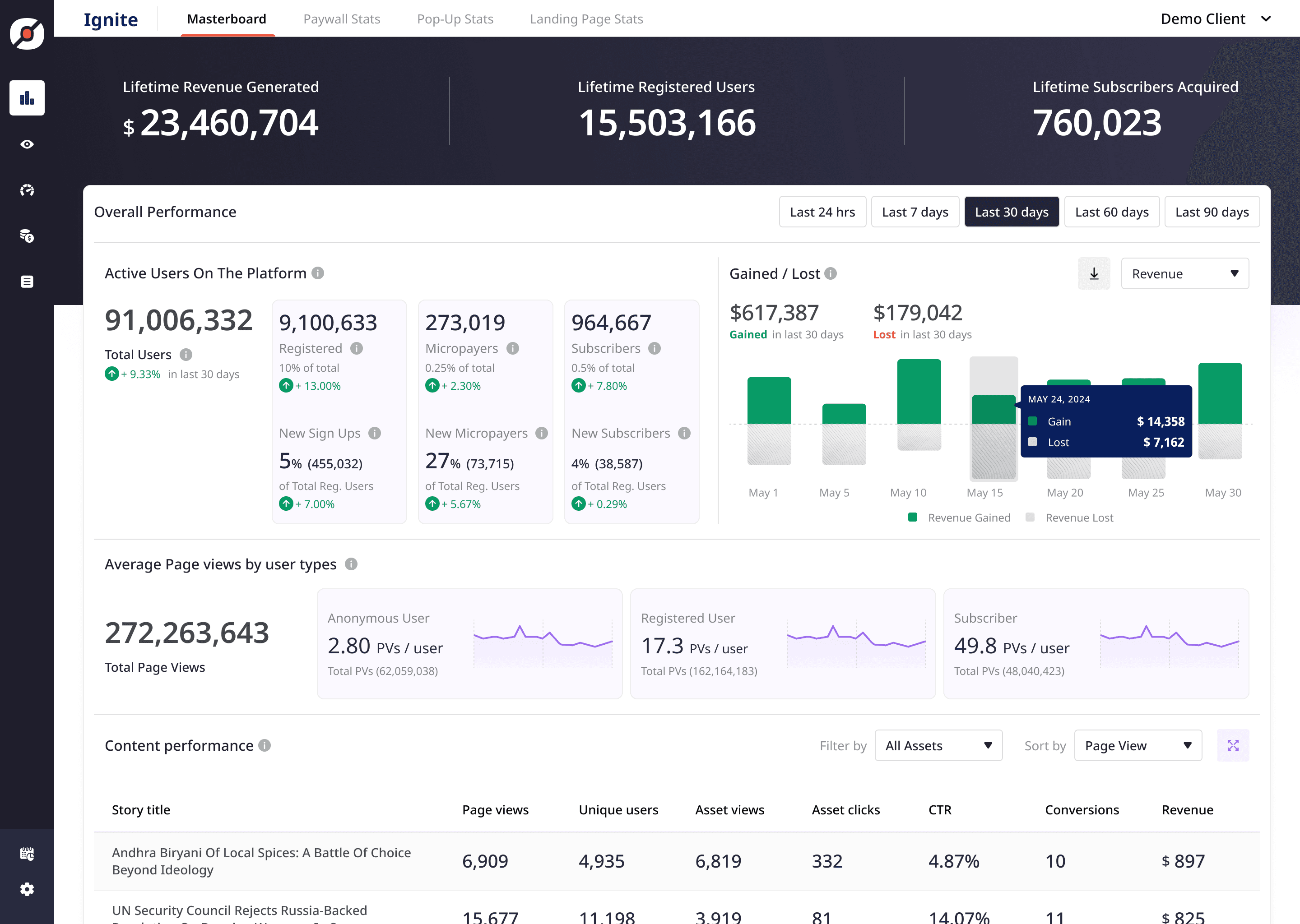8
mins read
By
Team Conscent
4 Sept 2024
How many subscriptions can the average consumer buy! Streaming platforms, music apps, commerce, and digital publications have all adopted subscription models. With too many content subscription services vying for a share of the same wallets, the competition is stiff and consumers are often left overwhelmed with the choices offered to them. And that's not it. The subscriptions they already have are also often difficult to manage - with yearly renewals, passwords, and finding content that might entertain or inform them, among other things.
Outcome? Subscription Fatigue.
"In the next two years, more than 200 small-to-large media houses will put their exclusive and analytical content behind a paywall. This is bound to fragment the subscription market and cause further confusion amongst consumers."
So, how can publishers avoid the situation before their subscribers hit fatigue?
In an attempt to find a potential solution, ConsCent's Co-Founder and CEO, Sunny Sen, recently spoke at a panel discussion sponsored by iZooto entitled "Solving Subscription Fatigue through Personalisation and Retention." In this panel, he was joined by Vishal Dembla, SVP- Asia, The Economist, and Nash David, Director- Content Marketing of iZooto, where subscription fatigue as a challenge was discussed in great depth.
Here are the most important takeaways from all the panelists' presentations, along with the top five ways publishers can combat subscription fatigue.
Is Subscription Fatigue Real? How can news publishers prevent it?- Panel Discussion with iZooto and The Economist.
Existing subscribers and loyalists are more likely to experience subscription fatigue
A user at the bottom of the user funnel, who is most captive, is usually the first to feel weary of their subscriptions. They are the most likely to experience frustration, or what we can also call subscription fatigue, since they are most exposed to the publisher's ecosystem. Sunny explains, "this is the audience which is bombarded with information, ads and offers from about 50-60 news platforms or video streaming players on a regular basis. This exposure causes information overload and eventually fatigue."
Another point to be noted with regards to this audience is that this is the same audience which once used to consume what was provided to them - via newspapers or prime time news reports - whereas today they have to make a conscious choice every day as to what they wish to read, watch, or listen to. The effort itself is quite taxing after a certain point of time.
Deloitte's 13th annual Digital Media Trends survey looked at ways to re-aggregate news and streaming services and recommend content based on consumers' preferences.
Subscription fatigue is actually subscription management and discovery fatigue
In today's lean forward content consumption pattern, consumers choose what they want to consume constantly, which can make subscriptions monotonous and exhausting. As Vishal Dembla of The Economist pointed out, "A consumer today has a hard time making a conscious decision about how he wishes to entertain himself. With so many subscription options available, consumers are constantly faced with deciding what they will find entertaining - something that can be frustrating, confusing, and annoying at the same time."
Any content platform that aims to increase user stickiness and engagement has to focus on two components. 1) Content and 2) Experience. Currently, publishers create content based on what is the most viewed content on their platform, and put it behind a paywall thinking subscribers will find value in it. In this process, however, the whole experience quotient is missing, which means it cannot be checked on a range of parameters such as; Are my subscribers finding value in it, are they engaging enough, am I able to bring them back to the platform, or is this even the content that my subscriber wants me to present him with?
You need to answer all of these questions in order to ensure your content is irresistible and continuously adds value to your subscribers throughout their lifetimes.
Ultimately, the problem it fails to solve is the pain point of the consumer, which is choosing content each day. And that’s where discoverability and user journey mapping comes into play.
Content discoverability is the new differentiator
With so much stuff at a consumer's fingertips, indecision about what to watch has become a modern problem. This is known in psychological terminology as a Paradox of Choice.
Experts would argue that the more alternatives available, the better, which is somewhat true. However, over time, it is tiresome. It occurs to many of us when we go online to read or search for a television series to watch. Infinite choices are available. Which may lead a customer to get confused and enter the mental paralysis stage, when they are unable to make a choice anymore.
Creating a curated list of content recommendations based on the behavioural segmentation of a consumer at multiple levels of their interaction with your platform, thereby preventing them from entering the paradox of choice or mental paralysis, will be the defining proposition for publishers and OTTs in the future.
Consequently, content discoverability will play a significant role in subscriber retention and also in addressing the long-tail in order to establish a stable readership or subscription revenue.
However, content discoverability is not the end of the road. Each customer has unique requirements, viewing habits, and propensity to pay.
Personalisation is the future
Personalisation makes the discovery process smarter. Targeting and curating customised content for different audiences has proven to be a boon for the advertising industry for years. Targeting and bringing the recommended content to the surface for that particular consumer can be a big relief from the paradox of choice as well as be an effective means for driving subscriptions, improving retention, and delivering a solid ROI on production costs.
"Publishers have started to program their editorial to have something (a new article, video, etc.) come in every day, not necessarily breaking news, but even if it is a thought piece, which mirrors the customer behaviour of tuning into something every single day. That is a volume of content."
Thus, it is incumbent on publishers to solve this for the customer. Vishal says, "Understand the customer's behaviour, their interests, surface content to them which is relevant and which is of their interest and choice."
While that is all necessary, what often gets missed is the need to have a personalisation and recommendation engine that works for and with the content creators and keeps getting smarter with the amount of data it captures. We see a very small number of publishers currently focussing on adopting a product mindset and making room for sophisticated technology that can map the user journey right from acquisition to retention and even churn control.
ConsCent's audience segmentation and recommendation solutions for publishers
Leverage the long tail
A significant portion of platform visitors, excluding loyalists, never access premium content or connect with a platform on an experienced level. This long-tail has 'zero fatigue' and is more likely to connect with and pay for your high-quality content.
According to our calculations, India has the potential to have more than 70-75 million paid news subscribers. To attract casual visitors to one's platform, the content discovery and recommendation system must be in place, followed by a more intelligent payment system that can dynamically alter the paywall to be shown to the user in question.
Studies indicate that if a user is presented the same paywall more than three times, there is an 80% likelihood that he or she would either go to another site to see the content for free or never return to the platform or consider paying for it.
Pricing differential comes into play at this point. From micropayments to subscriptions, a publisher should provide varying pricing points to distinct user cohorts based on how recent, frequent, and in-depth (RFV Scoring) their interactions are with the platform.
Optimise the user lifecycle
First-party data and insights are becoming more important for publications. When you have rich user data that you can analyse and predict the next steps that will improve your outcome or increase a consumer's LTV, you've progressed from simply counting daily MAUs or DAUs on your platform to actually optimising your user's lifecycle to provide the best experience in the long run.
Why is it necessary to optimise? Because digital customers are the future source of revenue for publishers.
Sunny argues that when it comes to optimising user journeys at each stage, "the user journey mapping from Day 0 to Day 360 should be done, where the cycle of the first 90 days is most significant.
We see the majority of the user attrition occurs during the first 90 days after purchase. The decreased engagement rate during this time period, which stems from a lack of product mentality or the necessity of user journey mapping, are some of the most serious concerns that the publisher must solve."
Then there's retention and reactivation, which is where you handle the loyalists, and here is where your emphasis must be razor-sharp. Because, believe it or not, the new acquisition is retention. And there are only two critical times for a publisher to handle in order to keep its loyal customers: pre-renewal and post-purchase.
As a consequence, in order to prevent audience fatigue, retention techniques and optimising a user's experience throughout the cycle are becoming practically mandatory for every forward-thinking publishing organisation.
ConsCent is trusted by over 50+ publishers to monetise their content and maximise reader revenue.
Written by:
Team Conscent
Category:
Subscriptions
Share this article





